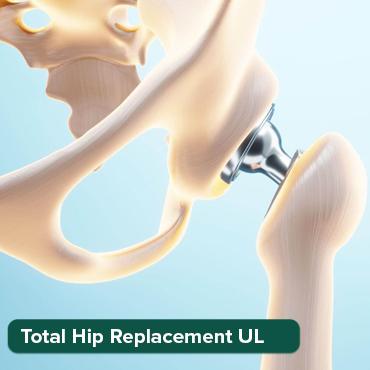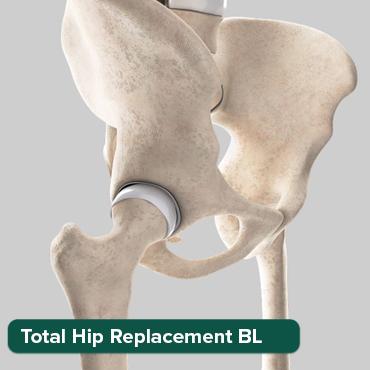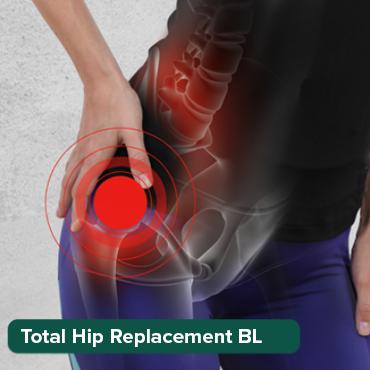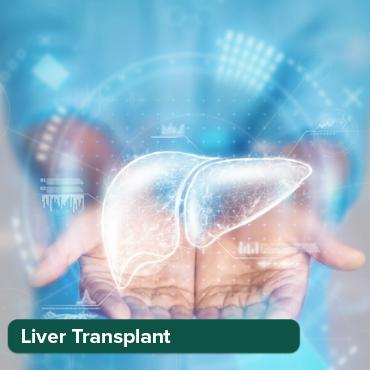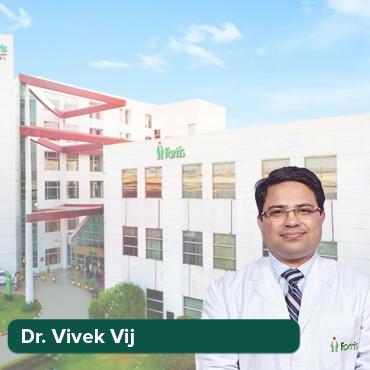
Side Effects and Risk Management of Joint Replacement
24 Sep, 2025
 Healthtrip
Healthtrip- Understanding Joint Replacement
- Common Side Effects of Joint Replacement Surgery
- Serious Risks and Complications After Joint Replacement
- Where to Seek Treatment for Joint Replacement and Potential Complications
- Risk Management Strategies Pre and Post-Surgery
- Examples of Successful Risk Management
- Conclusion
Common Side Effects and Risks of Joint Replacement
Following joint replacement surgery, it's normal to experience some degree of pain, swelling, and stiffness in the affected joint. These are typically the immediate post-operative effects as your body begins the healing process. Pain management is a key focus at hospitals like Vejthani Hospital and Yanhee International Hospital, where medical teams employ various strategies, including medication, nerve blocks, and physical therapy, to keep you comfortable. Swelling can be minimized with elevation and ice packs, while gentle exercises, guided by experienced physiotherapists, can help reduce stiffness and improve range of motion. While these side effects are common and usually temporary, it's important to follow your healthcare provider's instructions carefully to ensure a smooth recovery. Additionally, be actively involved in physical therapy at places like the BNH Hospital, as regaining strength and flexibility are key to a successful outcome. If you have any concerns about the pain, swelling, or stiffness you are experiencing, don't hesitate to reach out to your medical team for guidance and support; Healthtrip is available to help you find the support you need.
Most popular procedures in India
Infection
Infection is a potential risk with any surgical procedure, including joint replacement. While modern surgical techniques and sterile environments, such as those at Memorial Bahçelievler Hospital, significantly minimize this risk, it's still an important consideration. Infections can occur either at the surgical site or spread from another part of the body. Signs of infection include increased pain, redness, swelling, drainage from the incision, fever, and chills. If you experience any of these symptoms, it's crucial to seek immediate medical attention. Treatment typically involves antibiotics, and in some cases, additional surgery may be necessary to remove the infected tissue or implant. Hospitals such as Bumrungrad International Hospital and Mount Elizabeth Hospital follow strict infection control protocols to minimize the risk of infection, including pre-operative screening, meticulous surgical techniques, and post-operative monitoring. Healthtrip provides access to leading hospitals that prioritize patient safety and employ best practices to prevent and manage infections, so you can feel confident in the care you receive. Make sure to bring up any concerns you may have during your consult so that your doctor can discuss ways to minimize this risk.
Blood Clots
Blood clots are another potential complication following joint replacement surgery, as prolonged immobility during and after surgery can increase the risk of clot formation in the legs. These clots, known as deep vein thrombosis (DVT), can be dangerous if they travel to the lungs, causing a pulmonary embolism (PE). To prevent blood clots, surgeons at hospitals like Fortis Escorts Heart Institute and Saudi German Hospital Cairo often prescribe blood-thinning medications (anticoagulants) after surgery. They also recommend early mobilization, encouraging patients to get up and walk as soon as possible to promote blood circulation. Compression stockings can also help improve blood flow in the legs. Symptoms of DVT include pain, swelling, redness, and warmth in the leg, while symptoms of PE include shortness of breath, chest pain, and coughing up blood. If you experience any of these symptoms, seek immediate medical attention. Healthtrip helps you connect with reputable hospitals that prioritize preventative measures and prompt treatment of blood clots to ensure your safety and wellbeing. Don't hesitate to discuss your concerns with your Healthtrip representative to ensure you receive the best possible care.
Wellness Treatments
Give yourself the time to relax
Lowest Prices Guaranteed!

Lowest Prices Guaranteed!
Dislocation
After a hip or shoulder replacement, there is a risk of dislocation, where the ball of the new joint comes out of the socket. This is more common in the early stages of recovery when the surrounding tissues are still healing. To minimize the risk of dislocation, orthopedic surgeons at hospitals like Hisar Intercontinental Hospital and LIV Hospital provide specific instructions on movements to avoid, such as crossing your legs after a hip replacement. They also often recommend using assistive devices like elevated toilet seats and reaching aids to prevent excessive bending or twisting. Physical therapy plays a crucial role in strengthening the muscles around the joint and improving stability. If a dislocation occurs, it typically requires a prompt trip to the emergency department where the doctor will put it back in place. Following the guidelines provided by your medical team and adhering to your physical therapy program are essential for preventing dislocation and ensuring a successful recovery. Healthtrip works with facilities where doctors and physical therapists educate patients on proper movement and precautions to take, so you can feel confident in your rehabilitation process. Consult your Healthtrip case manager for more information about the precautions you should take during recovery.
Nerve or Blood Vessel Damage
Although rare, there is a risk of nerve or blood vessel damage during joint replacement surgery. The surgeons at facilities like Quironsalud Hospital Murcia and Quironsalud Hospital Toledo take extreme care to avoid these complications, nerves and blood vessels can sometimes be stretched or compressed during the procedure. Nerve damage can result in numbness, tingling, weakness, or pain in the affected area. Blood vessel damage can lead to bleeding or compromised blood flow. Most nerve injuries are temporary and resolve on their own with time and physical therapy. However, some may require further treatment, such as medication or surgery. Vascular injuries are typically addressed immediately during surgery to restore blood flow. Hospitals equipped with advanced imaging technology and experienced vascular surgeons, like those partnered with Healthtrip, are well-prepared to manage these complications effectively. Choosing a skilled and experienced surgeon and a reputable medical facility can significantly minimize the risk of nerve or blood vessel damage and ensure optimal outcomes. Healthtrip ensures that the hospitals can provide all necessary care.
Risk Management Strategies
Managing the risks associated with joint replacement surgery involves a multi-faceted approach, beginning with a thorough pre-operative evaluation at hospitals like NMC Specialty Hospital, Al Nahda, Dubai and NMC Royal Hospital, DIP, Dubai. This evaluation helps identify any underlying health conditions that could increase the risk of complications. The surgical team takes meticulous precautions during the procedure, including using sterile techniques, minimizing tissue trauma, and carefully monitoring vital signs. Post-operative care focuses on pain management, early mobilization, and preventing infection and blood clots. Regular follow-up appointments are essential for monitoring the healing process and addressing any concerns that may arise. Patient education plays a crucial role in risk management, empowering individuals to take an active role in their recovery by following instructions carefully, attending physical therapy sessions, and reporting any unusual symptoms to their healthcare providers. Healthtrip is dedicated to connecting you with healthcare providers who prioritize patient safety and employ comprehensive risk management strategies to ensure the best possible outcomes. Healthtrip is here to support our patients while they are receiving necessary care.
Pre-operative Assessment
A comprehensive pre-operative assessment is a critical step in minimizing the risks associated with joint replacement surgery. This assessment typically involves a thorough medical history review, a physical examination, and various diagnostic tests, such as blood tests, X-rays, and electrocardiograms (ECGs). The medical team evaluates your overall health status, identifies any pre-existing conditions that could increase the risk of complications, such as diabetes or heart disease, and optimizes your health before surgery. At hospitals like Saudi German Hospital Alexandria and Taoufik Clinic, Tunisia, the pre-operative assessment also includes a review of your medications, allergies, and lifestyle habits, such as smoking and alcohol consumption, which can impact healing. The team will also discuss the surgical procedure in detail, explain the potential risks and benefits, and answer any questions you may have. By gaining a clear understanding of your health status and addressing any potential risk factors, the pre-operative assessment helps ensure that you are well-prepared for surgery and that the surgical team can tailor the procedure to your individual needs. Healthtrip works with hospitals that prioritize comprehensive pre-operative assessments to optimize patient safety and outcomes, ensuring every step is taken to help the best possible outcome. Healthtrip representatives will help you find a location near you.
Surgical Techniques
Advancements in surgical techniques have significantly reduced the risks associated with joint replacement surgery. Minimally invasive techniques, such as those used at Helios Klinikum München West and Helios Emil von Behring, involve smaller incisions, less tissue damage, and faster recovery times compared to traditional open surgery. Computer-assisted surgery can improve the accuracy of implant placement, reducing the risk of misalignment and instability. The use of specialized instruments and techniques can also minimize the risk of nerve and blood vessel damage. Surgeons at hospitals with Healthtrip have extensive training and experience in performing joint replacement surgery using the latest techniques. They carefully select the most appropriate surgical approach based on your individual anatomy, health status, and the specific type of joint replacement you are undergoing. By employing advanced surgical techniques and prioritizing precision and careful execution, these surgeons minimize the risk of complications and optimize the long-term success of your joint replacement. Healthtrip is committed to connecting you with skilled surgeons who are at the forefront of joint replacement innovation.
Post-operative Care and Rehabilitation
Post-operative care and rehabilitation are crucial for a successful recovery after joint replacement surgery. Following surgery, you will receive pain management medications to keep you comfortable and allow you to participate actively in physical therapy. Physical therapy typically begins within a day or two of surgery and involves a progressive program of exercises designed to strengthen the muscles around the joint, improve range of motion, and restore function. At hospitals like Bangkok Hospital and BNH Hospital, physical therapists work closely with you to develop an individualized rehabilitation plan that addresses your specific needs and goals. They will teach you how to perform exercises safely and effectively and provide guidance on activities to avoid. Regular follow-up appointments with your surgeon are essential for monitoring your progress and addressing any concerns that may arise. Adhering to your post-operative instructions, attending physical therapy sessions regularly, and gradually increasing your activity level are essential for achieving a full recovery and maximizing the benefits of your joint replacement. Let Healthtrip help you find a physical therapy clinic that fits your budget and needs.
Understanding Joint Replacement
Joint replacement surgery, also known as arthroplasty, is a transformative procedure designed to alleviate pain and restore mobility in damaged joints. Imagine your joints as finely tuned hinges that allow you to move freely and comfortably. When these hinges become worn or damaged due to arthritis, injury, or other conditions, everyday activities can become incredibly challenging and painful. Joint replacement steps in as a solution, replacing the damaged joint surfaces with artificial implants, often made of metal, plastic, or ceramic. The goal is to create a smooth, functional joint that moves without pain. Think of it as giving your body's hinges a much-needed upgrade. The most commonly replaced joints are the hip and knee, but joint replacement can also be performed on the shoulder, elbow, ankle, and wrist. The decision to undergo joint replacement is a significant one, typically considered when conservative treatments like medication, physical therapy, and lifestyle modifications no longer provide adequate relief. It's a collaborative process between you and your orthopedic surgeon, carefully weighing the potential benefits against the risks involved. Healthtrip facilitates these crucial connections between patients and world-class orthopedic specialists, ensuring you have access to the best possible care and guidance throughout your joint replacement journey. We connect you with hospitals like Fortis Hospital, Noida and Max Healthcare Saket, which are renowned for their expertise in joint replacement surgery, ensuring access to cutting-edge techniques and compassionate care.
The process begins with a comprehensive evaluation, including a physical examination, imaging tests (such as X-rays or MRI scans), and a discussion of your medical history. This allows the surgeon to assess the extent of the joint damage and determine if joint replacement is the right option for you. The surgery itself involves removing the damaged bone and cartilage and replacing them with the artificial joint components. These components are carefully selected and sized to match your individual anatomy, ensuring a proper fit and optimal function. Following surgery, a period of rehabilitation is crucial to regain strength, flexibility, and range of motion in the new joint. Physical therapy plays a vital role in this process, guiding you through exercises and activities designed to promote healing and restore mobility. The recovery timeline varies depending on the individual and the specific joint replaced, but most patients experience significant improvement in pain and function within a few months. Healthtrip understands that navigating the complexities of joint replacement can be overwhelming. That's why we provide personalized support and assistance every step of the way, from finding the right surgeon to coordinating travel arrangements and ensuring a smooth recovery. It's about making your journey as comfortable and stress-free as possible, so you can focus on regaining your quality of life.
Common Side Effects of Joint Replacement Surgery
While joint replacement surgery is generally safe and effective, it's important to be aware of the potential side effects that can occur during the recovery period. These side effects are often temporary and manageable with proper care and attention. Understanding what to expect can help you prepare for the recovery process and address any concerns proactively. One of the most common side effects is pain. Post-operative pain is a natural part of the healing process, but it can be effectively managed with pain medication prescribed by your doctor. The intensity of the pain varies from person to person, but it typically decreases over time as the tissues heal. Swelling and inflammation are also common in the surgical area. Elevating the limb and applying ice packs can help reduce swelling and provide relief. Bruising may also occur around the incision site, which usually fades within a few weeks. Stiffness in the joint is another potential side effect, especially during the initial stages of recovery. Physical therapy plays a crucial role in minimizing stiffness and restoring range of motion. Regular exercise and stretching can help loosen the joint and improve flexibility.
Infection is a potential risk with any surgical procedure, including joint replacement. While rare, infections can occur at the incision site or around the artificial joint. Symptoms of infection include redness, warmth, swelling, drainage, and fever. It's essential to follow your surgeon's instructions carefully regarding wound care and hygiene to minimize the risk of infection. Blood clots are another potential complication, particularly in the legs (deep vein thrombosis or DVT). Blood clots can cause pain, swelling, and redness in the affected leg. In some cases, blood clots can travel to the lungs (pulmonary embolism), which is a life-threatening condition. Your doctor may prescribe blood thinners to help prevent blood clots. Numbness or tingling around the incision site is also possible due to nerve irritation or damage during surgery. This is usually temporary and resolves on its own over time. However, in some cases, it may persist. Healthtrip recognizes the importance of providing comprehensive support during the recovery period. We connect you with healthcare professionals who can help manage these common side effects and address any concerns you may have. Hospitals like Saudi German Hospital Cairo, Egypt and Fortis Memorial Research Institute, Gurgaon offer comprehensive post-operative care programs to ensure a smooth and successful recovery.
Furthermore, individuals might experience some level of fatigue following surgery as the body dedicates energy to healing. This fatigue is generally temporary and diminishes as recovery progresses. Maintaining a healthy diet, staying hydrated, and getting adequate rest can substantially mitigate this side effect. Healthtrip emphasizes the significance of holistic recovery approaches. Our services include facilitating access to nutritional counseling and rehabilitation programs that are designed to bolster your recovery and overall well-being. We endeavor to ensure you are fully equipped to manage these typical side effects effectively, thereby contributing to a more pleasant and successful recovery experience. Remember, open communication with your healthcare team is key. If you experience any unexpected or concerning symptoms, don't hesitate to contact your doctor or physical therapist. Early intervention can often prevent minor issues from becoming more significant problems.
Serious Risks and Complications After Joint Replacement
While joint replacement surgery has a high success rate, it's important to be aware of the potential serious risks and complications that can occur, although they are relatively rare. Understanding these potential issues allows you to be informed and proactive in your care. One of the most significant risks is dislocation of the artificial joint. This occurs when the ball of the joint comes out of the socket. Dislocation is more common in the early stages of recovery, especially with hip replacements. Following your surgeon's instructions regarding movement restrictions and precautions can help prevent dislocation. Revision surgery may be necessary to correct a dislocated joint. Another potential complication is loosening of the artificial joint components. Over time, the implants can loosen from the bone, causing pain and instability. This is more common in younger, more active patients and may require revision surgery to replace the loose components. Infection, as mentioned earlier, is a risk that can have serious consequences. A deep infection around the artificial joint can be difficult to treat and may require multiple surgeries and long-term antibiotic therapy. In severe cases, the infected joint may need to be removed. Nerve damage is another potential complication that can occur during surgery. This can lead to numbness, tingling, weakness, or pain in the affected limb. Nerve damage is usually temporary, but in some cases, it can be permanent. Healthtrip understands the importance of minimizing these risks and ensuring patient safety. We connect you with highly skilled and experienced orthopedic surgeons who take every precaution to prevent complications. Hospitals such as Memorial Sisli Hospital in Istanbul and Quironsalud Hospital Murcia adhere to strict protocols and standards to minimize the risk of infection and other complications.
Furthermore, there's also the risk of blood clots, which, if untreated, can lead to pulmonary embolism, a life-threatening condition where a blood clot travels to the lungs. Symptoms include shortness of breath, chest pain, and coughing up blood. Prompt medical attention is critical if you experience these symptoms. Joint stiffness can sometimes become a chronic issue, limiting the range of motion and function of the replaced joint. This often requires intensive physical therapy and, in some cases, additional surgical procedures to release scar tissue and improve mobility. Implant failure is another rare but serious complication. Artificial joints can wear out or break over time, requiring revision surgery to replace the damaged components. The lifespan of an artificial joint varies depending on the individual and the type of implant used. Healthtrip emphasizes transparency and informed decision-making. We ensure that you have a comprehensive understanding of the potential risks and complications associated with joint replacement surgery. Our affiliated hospitals and surgeons provide detailed pre-operative counseling and post-operative monitoring to minimize the likelihood of these issues. Moreover, we understand that unforeseen medical issues can arise. Healthtrip is committed to providing ongoing support and assistance to our patients, even after their initial treatment. We can help coordinate follow-up care, connect you with specialists, and provide access to resources to manage any complications that may arise. Our goal is to ensure that you receive the best possible care throughout your entire joint replacement journey.
Beyond the previously mentioned risks, a less common but potential issue is heterotopic ossification, where bone forms in the soft tissues surrounding the joint. This can cause pain and stiffness, potentially limiting joint movement. Medication and radiation therapy are sometimes used to manage this condition. Additionally, differences in leg length can occur after hip replacement, impacting gait and requiring shoe lifts. While surgeons strive to minimize this, it remains a possibility. Allergic reactions to the implant materials are also rare but can cause pain, swelling, and inflammation around the joint, potentially necessitating implant removal. Healthtrip takes a patient-centered approach, appreciating that each individual’s medical journey is unique. We provide personalized support, linking you with specialists equipped to handle any specific complications that might arise, ensuring your peace of mind throughout your treatment process. Remember, being well-informed and working closely with your healthcare team are crucial for mitigating these risks and achieving the best possible outcome from your joint replacement surgery.
Also Read:
Where to Seek Treatment for Joint Replacement and Potential Complications
Navigating the path of joint replacement can feel overwhelming, especially when considering where to receive treatment and address potential complications. It's crucial to choose a medical facility and team with extensive experience in orthopedic surgery and dedicated post-operative care. The selection process should involve thorough research, including checking hospital accreditations, surgeon credentials, and patient reviews. A multidisciplinary approach involving orthopedic surgeons, physical therapists, pain management specialists, and rehabilitation experts is generally recommended. Consider whether the hospital utilizes advanced technologies like robotic-assisted surgery or computer navigation, which can potentially improve precision and recovery times. For international patients, Healthtrip can provide valuable assistance in identifying suitable healthcare providers and facilitating travel arrangements. We understand that undergoing surgery far from home requires careful planning, and we are here to support you every step of the way, from initial consultations to post-operative follow-up.
Hospitals Offering Treatment
When exploring hospitals for joint replacement, several internationally recognized institutions stand out for their orthopedic expertise and patient care. In Germany, OCM Orthopädische Chirurgie München boasts a strong reputation for orthopedic surgery. In Turkey, both Memorial Bahçelievler Hospital and LIV Hospital, Istanbul, offer comprehensive orthopedic programs with experienced surgeons. Over in Thailand, Vejthani Hospital and Bangkok Hospital are popular choices for medical tourism, known for their advanced facilities and skilled medical professionals. Within the United Arab Emirates, NMC Specialty Hospital, Al Nahda, Dubai and Thumbay Hospital in Dubai can also be considered. In India, Fortis Escorts Heart Institute and Fortis Shalimar Bagh and Max Healthcare Saket are reputable options providing quality orthopedic care. Finally, in Spain, Quironsalud Hospital Toledo is a good option. Remember to check Healthtrip for the latest information and patient reviews on these hospitals. Visiting the hospital's website and contacting them directly can also provide valuable insights into their services and expertise. Healthtrip can assist in arranging virtual consultations with these hospitals to help you make an informed decision, and can also provide help with hospital selection and related travel arrangements.
Risk Management Strategies Pre and Post-Surgery
Proactive risk management is paramount for a successful joint replacement journey. Prior to surgery, a comprehensive medical evaluation is essential to identify any pre-existing conditions that could potentially affect the outcome. This includes assessing cardiovascular health, managing diabetes, and addressing any infections. Optimizing your overall health through lifestyle modifications such as smoking cessation, weight management, and a nutritious diet is crucial. Engaging in pre-operative physical therapy can strengthen the muscles around the affected joint, which can improve post-operative recovery. Post-surgery, adherence to the rehabilitation protocol is key to regain function and prevent complications. This includes following the prescribed exercises, using assistive devices as recommended, and attending follow-up appointments. Maintaining a healthy weight, avoiding high-impact activities, and protecting the joint from injury can help prolong the lifespan of the implant. Early detection and management of potential complications, such as infections or blood clots, are vital. Healthtrip can connect you with experienced orthopedic surgeons who emphasize a proactive approach to risk management, tailoring the treatment plan to your individual needs and circumstances. Regular communication with your healthcare team and reporting any concerns promptly are essential for a smooth and successful recovery.
Examples of Successful Risk Management
Real-life examples of successful risk management in joint replacement highlight the importance of proactive strategies and patient adherence to medical advice. Consider the case of a 65-year-old patient with osteoarthritis who underwent a total knee replacement. Prior to surgery, they participated in a pre-habilitation program that focused on strengthening the quadriceps and hamstring muscles. Post-operatively, they followed a strict physical therapy regimen, gradually increasing their activity level. They also maintained a healthy weight and avoided activities that could put excessive stress on the new joint. As a result, they experienced a rapid recovery, regained full range of motion, and returned to their favorite hobbies within a few months. Another example involves a patient with a history of diabetes who underwent a hip replacement. Meticulous control of their blood sugar levels before and after surgery minimized the risk of infection. They also received prophylactic antibiotics and were closely monitored for any signs of wound complications. Their dedication to managing their diabetes and adhering to post-operative instructions contributed to a successful outcome. These cases underscore the importance of individualized risk assessment, patient education, and a collaborative approach between the patient and healthcare team. Healthtrip aims to empower patients with the knowledge and resources they need to actively participate in their own care, promoting successful joint replacement outcomes.
Also Read:
Conclusion
Joint replacement surgery is a transformative procedure that can significantly improve quality of life for individuals suffering from chronic joint pain and disability. By understanding the potential risks and complications, implementing proactive risk management strategies, and seeking treatment from experienced medical professionals, patients can maximize their chances of a successful outcome. Healthtrip is dedicated to providing comprehensive resources and support to guide you through every step of your joint replacement journey. From connecting you with world-class hospitals and surgeons to facilitating travel arrangements and providing post-operative care guidance, we are committed to ensuring a seamless and positive experience. Remember, informed decision-making, proactive management, and close collaboration with your healthcare team are essential for achieving long-term success. Do not hesitate to reach out to Healthtrip for personalized assistance and to explore the possibilities of regaining pain-free mobility and an active lifestyle.
Related Blogs

Complete Cost Breakdown of Eye Surgery with Healthtrip
Learn about doctors, hospitals, procedures, and recovery for eye surgery

How to Prepare for Your Eye Surgery in India
Learn about doctors, hospitals, procedures, and recovery for eye surgery

Side Effects and Risk Management of Eye Surgery
Learn about doctors, hospitals, procedures, and recovery for eye surgery

Follow-Up Care for Eye Surgery Patients with Healthtrip Assistance
Learn about doctors, hospitals, procedures, and recovery for eye surgery

Best Hospital Infrastructure for Eye Surgery
Learn about doctors, hospitals, procedures, and recovery for eye surgery

What to Expect During a Eye Surgery Consultation
Learn about doctors, hospitals, procedures, and recovery for eye surgery
